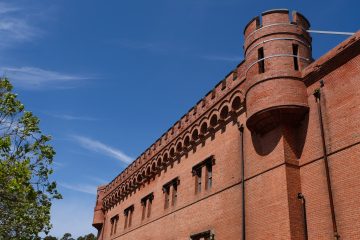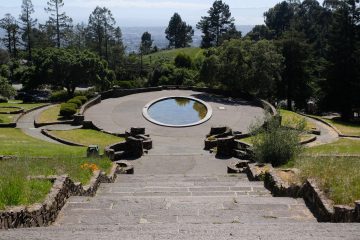Hidden East Bay Wonders: Once The Largest Winery in the World, Abandoned in Richmond, CA
Hidden East Bay Wonders brings you everything weird, whimsical and wonderful in the East Bay. This week: the abandoned Winehaven winery in Richmond.

Winehaven in its heyday a century ago–with boats leaving the Winehaven Dock every few hours for markets across the globe
After the devastation of the 1906 earthquake in San Francisco, the California Wine Association, a conglomerate of seven leading wine firms in California, moved from their SOMA headquarters in San Francisco to Richmond’s Point Molate, a promontory on the east shore of the San Pablo Bay, where they would build a new winery of unparalleled architectural beauty: Winehaven.

Breathtaking crenellated parapets crown bastions that jut from the side of the red brick. Battlements and their arched corbels today house the nests of English
Before the cities of Napa and Sonoma would become synonymous with wine, over 400 workers at Winehaven worked to produce 12 million gallons of wine each year, shipping 500,000 gallons each month to markets on both coasts of the United States and across the globe. Winehaven even had its own functioning post office (operational until 1925) and several rows of turn-of-the-century cottage-style houses, where workers would live on-site during peak season.

Winehaven 1918. Richmond Public Library
Prohibition put an end to all the splendor in 1919. The California Wine Association was forced to sell its assets or risk bankruptcy. Winehaven sat mostly unused and abandoned until 1941 when the U.S. Navy bought the property and installed a fuel depot on the grounds, building enormous reservoirs into the hillside. They used the nearby Winehaven Dock to ship fuel during both the Korean and Vietnam wars, and, like the wine workers, Navy men lived in the houses on site until it was ultimately decommissioned in 1995.

You can drive right past these cottages on Stenmark Drive. You can even see some of the winery from the road.
Astonishingly, the remnants of Winehaven remain well-preserved today. Over 35 buildings on the property built between 1907 and 1919 are recognized by the National Register Historic District.

Along Winehaven’s western-facing facade, train tracks ran wine directly to the nearby Winehaven Dock.

Winehaven is massive–as you round the corner on the little dirt road, you will be awestruck at the otherworldliness of this place.
The most prominent ruin in the area is the magnificent and massive winery itself, with its hybrid Moorish-Iberian castle-like style, its gorgeous stonework of crenellated parapets, corner bartizans crowned with merlons and arrow slits, and ramparts with battlements supported by arched corbels. The red brickwork of the building pops out from the surrounding copse of eucalyptus trees, making for spectacular eye candy.

A ladder leads to up to the crumbling roof. Careful here–there are areas where you can fall through.
Security guards patrol the area frequently, so be careful if you want to visit. Fines are steep if you get caught and you can go to jail. But if you feel up for an adventure, walk from nearby Point Molate Beach Park about a mile along the shoreline at low tide until you see a road on an escarpment above. Follow the road until you reach the buildings. Be careful–the area is dangerous and untended.















